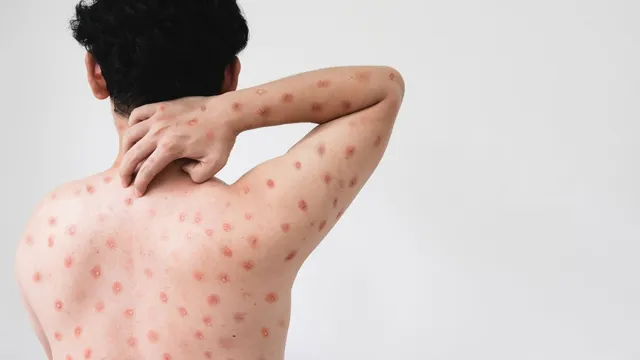- By Priyanka Munshi
- Fri, 20 Sep 2024 09:51 AM (IST)
- Source:JND
Mpox is a viral disease that has gained significant attention due to its major impact on public health. Knowing everything about Mpox is important for raising awareness among people so they can recognize early symptoms, consult doctors, and prevent the disease from spreading to others. Mpox is primarily transmitted through close contact with an infected person, animal, or contaminated materials, and like many other viruses, it can spread easily.
Mpox typically presents with flu-like symptoms, such as fever, fatigue, and swollen lymph nodes. In addition, a rash may develop and spread across the body. Being familiar with these symptoms allows for early action, which can protect you from complications and reduce the risk of spreading the disease to others.
Understanding the symptoms and learning how to test for Mpox are crucial steps in preventing its spread. A doctor can test for Mpox by taking a sample from a blister on your skin or by swabbing the throat, as Mpox commonly affects the mucous membranes. These tests can quickly determine whether a person has Mpox. If you are diagnosed, proper isolation and care are necessary to prevent the transmission to others. In an interview with Jagran English, Dr. Niranjan Patil, Associate Vice President (AVP) and Scientific Business Head for Infectious Diseases at Metropolis Healthcare Ltd in Mumbai, discussed faster ways to test for Mpox.
According to Dr. Patil, Mpox is typically a self-limited disease, with symptoms lasting 2 to 4 weeks. Severe cases are more common in children and are influenced by factors such as viral exposure, the patient’s health status, and the nature of complications. The rate of asymptomatic infections is still unknown. Historically, the case fatality ratio (CFR) of Mpox has ranged from 0% to 11%, with a higher rate among young children. Recently, the CFR has been around 3% to 6%.
Diagnosis Of Mpox:
Mpox can be clinically diagnosed based on medical history, symptom progression, physical signs, and epidemiological risk factors, such as contact with infected individuals or recent travel to affected areas. However, laboratory confirmation is necessary for a definitive diagnosis and to implement preventive measures.
Also Read: Expert Reveals 5 Important Reasons Why Women Should Focus On Nutrition In Their 30s
Case Definitions:
Suspected Case: Any individual with a history of travel to affected regions within the last 21 days who presents with an unexplained acute rash and one or more of the following symptoms:
- Swollen lymph nodes
- Fever
- Headache
- Body aches
- Severe weakness
Probable Case: A person meeting the criteria for a suspected case with compatible illness and an epidemiological link (e.g., face-to-face contact, healthcare workers without proper PPE, direct physical contact with skin or lesions, or contact with contaminated materials like clothing or bedding).
Confirmed Case: A laboratory-confirmed case of Mpox, detected through unique viral DNA sequences via polymerase chain reaction (PCR) or sequencing.
Laboratory Diagnosis:
Personal Protective Equipment (PPE): Healthcare workers handling clinical specimens must wear PPE, including coveralls/gowns, an N-95 mask, a face shield or safety goggles, and double-layered gloves.
Specimen Collection:
- Use a 1 ml intradermal syringe to collect pustular or vesicular fluid from multiple lesions, storing it in a screw-cap plain tube.
- Scrape the base of lesions using a polystyrene swab and place the sample in a screw-cap plain tube.
- If scabs or crusts are present, collect them with a polystyrene swab and store them in a screw-cap plain tube.
Storage: If specimens are not tested promptly, refrigerate them at 2-8°C or freeze them at -20°C or lower. Specimens can be tested up to 7 days from collection when stored at 2-8°C.
Recommended Test: The Mpox DNA PCR test from skin lesions or buccal swabs is the preferred diagnostic test. Serological tests like the Mpox Antigen and IgM tests are available but not recommended for definitive detection.
Handling of Specimens: Specimens from suspected Mpox cases should only be handled by trained personnel in properly equipped laboratories, and must be transported in triple packaging according to WHO guidelines for infectious substances.
Infection Prevention At Home:
For patients not requiring hospitalization, the following measures should be taken at home to prevent the spread of Mpox:
- Isolate the patient in a separate room from other household members, and limit contact.
- The patient should not leave home except for medical care, and visitors should not be allowed.
- Household members should consider wearing masks and disposable gloves when in contact with the patient or their lesions.
- Cover lesions with long sleeves or pants to minimize contact.
- Dispose of contaminated waste, such as dressings, in biomedical waste bags.
- Practice thorough handwashing or use alcohol-based sanitizers after contact with lesions or contaminated materials.
- Wash bedding, towels, and clothes with warm water and detergent.
- Avoid sharing utensils and dishes with the patient, and clean them thoroughly.
- Clean and disinfect contaminated surfaces with standard household cleaners.
- Keep pets away from the patient.
Dr. Niranjan Patil emphasizes that anyone who develops symptoms such as fever and rash, especially if they have been in an area with Mpox cases or have had contact with an infected individual, should immediately seek medical attention.

